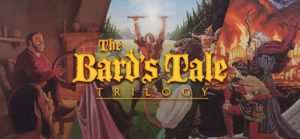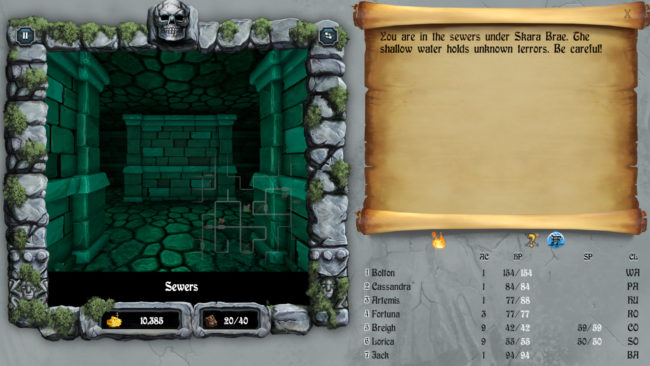From Tales of the Rampant Coyote
 I first played The Bard’s Tale on the Commodore 64 many, many years ago (when it was new). I’d played Wizardry on friends’ computers, but it still hadn’t made its way to my beloved C-64. The Bard’s Tale was not only a great substitute, but it tried hard to be a superior title. Graphically, it was certainly more impressive, with full color graphics and limited animation in a first-person dungeon crawler. It had some really neat features that made gameplay and character development more interesting (at least for spellcasters). At the time, it was clearly a major entry in computer role-playing games.
I first played The Bard’s Tale on the Commodore 64 many, many years ago (when it was new). I’d played Wizardry on friends’ computers, but it still hadn’t made its way to my beloved C-64. The Bard’s Tale was not only a great substitute, but it tried hard to be a superior title. Graphically, it was certainly more impressive, with full color graphics and limited animation in a first-person dungeon crawler. It had some really neat features that made gameplay and character development more interesting (at least for spellcasters). At the time, it was clearly a major entry in computer role-playing games.
I put many, many hours into it. And I died. A lot. I grew frustrated – in part from the game, in part from the limitations of its interface (quite common in similar games back then), and in part due to the notoriously slow disk access on the Commodore 64. Sadly, just at the point where I was finally making decent progress, I… quit playing. It wasn’t a conscious act, I just never returned to my last saved game. But it inspired me, and one of my few assembly language programming projects on the C-64 was to create a similar graphics window painting a full-color first-person perspective scene in a city for a dungeon crawler like Bard’s Tale.
I got even less far in Bard’s Tale II. Years later, I revisited some of those early dungeons in Bard’s Tale Construction Set (which were included with the demo campaign), and then I used an emulator to replay the original games–but never to completion, despite my best intentions. The older graphics didn’t bug me, but some of the old interface conventions, limitations, and rough edges really slowed it down for me. And for some reason, I can’t get into creating my own maps on graph paper anymore.
Now, in conjunction with the release of Bard’s Tale IV (which looks pretty awesome, BTW, but I’ve only played a little of it so far), they’ve released a “remastered” edition of the original Bard’s Tale trilogy. Currently, only the first of the three games (“chapters”) has been released. The second is due in fall, and the third in winter. In spite of my schedule the last couple of weeks, I’ve put several hours into the remaster.
And you know what? IT IS AWESOME! And I think I’m finally going to beat the entire trilogy this time around. 
Besides graphics improvements and more modern interface enhancements, there have been a large number of “quality of life” improvements added to this version. This includes a built-in automap function, somewhat less grinding (there’s still plenty of it, don’t worry), revised balance and improved mechanics from later games retroactively applied to the earlier game(s), more information and mechanics available at your fingertips, the ability to use the seventh slot for a player character instead of only summoned / recruited creatures, the ability to load or save from anywhere in the game (except in combat), and so forth.
In short, it is now up to the standards of a modern indie game. After putting a few hours into it, I have to say that I think this is a really sweet “remaster.” The updates have really sanded down the rough edges that always got in the way of having fun in the past. We’re left with a really solid CRPG that had some really impressive, advanced concepts for its time. In my mind, it’s removed a lot of the barriers to “having fun.”
So far, I find the game is still punishingly difficult at low levels. However, this is offset by the quality of life improvements. Being able to save / load freely (and quickly) really helps, and I think there are lower XP requirements means you can escape those hellish lower levels pretty quickly. Hopefully, you’ve learned how to try and run away by that point. Even at higher levels, the game will sometimes throw groups of monsters at you that you just can’t beat. Random chance is still a significant factor, but at least now you can save frequently and have better control over other things to help mitigate the disasters.
 Now, some will say that this isn’t the “real” game. That this isn’t capturing the “true” essence of The Bard’s Tale circa 1985. And maybe they are right. But for me, the true “old school feel” isn’t in the inability to save or load anywhere, or the uselessness of rogues in the original release of the first chapter, or in taking twice the grinding to level up. If that is what it defines it for you, there is always the emulated version of the original, or the upcoming “Legacy” mode for this game, which promises to take away your automaps, your ability load anywhere, and many of the other ‘quality of life’ enhancements. It’ll keep the new graphics and UI though.
Now, some will say that this isn’t the “real” game. That this isn’t capturing the “true” essence of The Bard’s Tale circa 1985. And maybe they are right. But for me, the true “old school feel” isn’t in the inability to save or load anywhere, or the uselessness of rogues in the original release of the first chapter, or in taking twice the grinding to level up. If that is what it defines it for you, there is always the emulated version of the original, or the upcoming “Legacy” mode for this game, which promises to take away your automaps, your ability load anywhere, and many of the other ‘quality of life’ enhancements. It’ll keep the new graphics and UI though.
So far, my forays into the dungeons below Skara Brae haven’t taken me as far as my original expeditions on my C-64, but I’m only about 9 hours in. This should be a reminder that old-school RPGs were typically pretty epic in length. In these old games, you don’t typically blitz through a dungeon level in a single trip, and then activate a two-way teleporter at the end. No, these dungeons were experienced in repeated forays, mapping a bit, and then pulling back before resources dropped too low so you could survive the trip back to the entrance.
There’s something very satisfying to me about this style of RPG gameplay. Now, I don’t know that The Bard’s Tale was ever a great example of the style–the series had its flaws and I don’t think those have entirely gone away with this remaster. But it’s still a classic game, and it’s still a really good CRPG well worth playing today–even in the modern era with lots of great competition. Now, with new graphics, a cleaner interface, and performing well on modern machines, I think The Bard’s Tale is better than ever.
Original URL: http://rampantgames.com/blog/?p=12087
